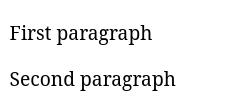HTML: Paragraphs
Paragraphs are the main way to divide a large text into small logical blocks. These blocks are automatically "indented" from each other. Such text is much easier to read and does not scare users.
Paragraphs are mostly found within large text. For example, any lesson on Hexlet or Code Basics is broken up into paragraphs for easy reading, just like this one.
It is broken down into small blocks of meaning. Not only is it more comfortable to read, but you can quickly find the information you need in a large text.
Paragraphs are created using the paired <p> tag with a small amount of text in the body. For example:
<p>First paragraph</p>
<p>Second paragraph</p>This is what they look like in the browser:

Instructions
Wrap the phrase Hello, World in a paragraph tag
Tips
Paragraphs cannot be nested within each other
If you've reached a deadlock it's time to ask your question in the «Discussions». How ask a question correctly:
- Be sure to attach the test output, without it it's almost impossible to figure out what went wrong, even if you show your code. It's complicated for developers to execute code in their heads, but having a mistake before their eyes most probably will be helpful.
Tests are designed so that they test the solution in different ways and against different data. Often the solution works with one kind of input data but doesn't work with others. Check the «Tests» tab to figure this out, you can find hints at the error output.
It's fine. 🙆 One task in programming can be solved in many different ways. If your code passed all tests, it complies with the task conditions.
In some rare cases, the solution may be adjusted to the tests, but this can be seen immediately.
It's hard to make educational materials that will suit everyone. We do our best but there is always something to improve. If you see a material that is not clear to you, describe the problem in “Discussions”. It will be great if you'll write unclear points in the question form. Usually, we need a few days for corrections.
By the way, you can participate in courses improvement. There is a link below to the lessons course code which you can edit right in your browser.
Your exercise will be checked with these tests:
const { test } = require('tests');
test(({ query, expect }) => {
const element = query(document, 'p', HTMLParagraphElement);
expect(element).to.contain.text('Hello, World');
});Teacher's solution will be available in:
20:00
